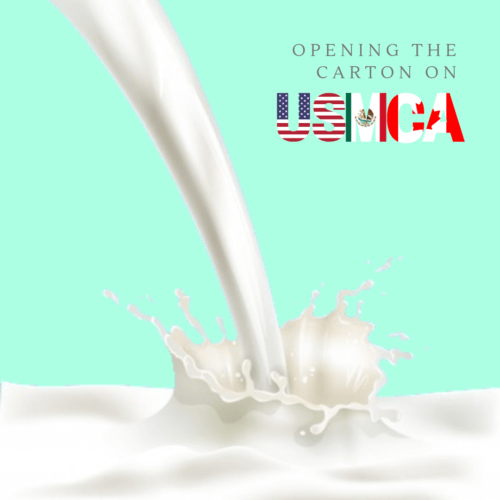By Jordan Schiewe, University of Saskatchewan Student
Why the new trade deal has Canadian dairy producers concerned for the future
After two long years and many negotiation rounds, on September 30, 2018, a new trade agreement named USMCA was born. USMCA stands for the United States-Mexico-Canada Agreement. This agreement is the result of Trump’s presidential campaign of wanting to restructure the North American Free Trade Agreement (NAFTA), aka the “worst trade deal ever made” (Wagner, 2018). However, the new USMCA deal remains relatively unchanged from the original NAFTA. With that being said, according to Canadian farmers one of the biggest industries impacted from the new deal is Canadian agriculture. More specifically the Canadian dairy industry.
What has Changed?
The USMCA has opened up part of the supply managed Canadian dairy sector to US made dairy products. Supply management is a system that regulates how much milk can be produced by Canadian dairy producers (Dairy Farmers of Canada, 2018). This quota system is based on the amount of demand by consumers. This helps in creating more stable prices for dairy producers in Canada. Under the new USMCA agreement, American dairy producers now have access to 3.59 percent of the Canadian market. This 3.59 percent is open to fluid milk, cheese, cream, and butter products (Real Agriculture, 2018). The other change brought up by the new trade deal is the elimination of Class 6 & 7 milk classes (Real Agriculture, 2018). Class 6 & 7 milk are skim milk components that are used to make milk powders or milk protein concentrates. These two classes were deemed as protein ingredients, so American producers could import them into Canada, without high tariffs, as it would be with dairy products (Glen, 2018). The elimination of Class 6 & 7 milk will grant the market access back to American, and global producers.
Beginning of the End for Supply Management?
The biggest issue from the new USMCA agreement is that it has many farmers believing this is only the start of phasing out supply management. With 3.59 percent market access for the US, it takes a big chunk of money from an industry that produces $19.9 billion of Canada’s GDP annually (Maclean’s, 2018). If this small amount of market access has this big of an impact on the industry, the question becomes how much more access can we afford to give up? By moving away from a supply managed industry, the market could potentially become over-supplied with dairy products from all over the world. Not only the USMCA, The Comprehensive Economic and Trade Agreement (CETA) has given the European Union access to 18,500 tonnes of cheese imports to Canada (Charlebois, 2017). These new market accesses lead to price drops due to increased competition, potentially hurting Canadian producers. Over 222,000 Canadian families depend on the Canadian dairy industry to support themselves. On the flip side, consumers would benefit from more competition by paying less for their dairy products. From the USMCA however, consumers will not see a change in the price they pay for dairy products in the near future (Real Agriculture, 2018).
The Future of Canadian Dairy Production
With every trade deal, there are always winners and losers. In the case of the USMCA, the Canadian dairy industry definitely finished as a loser. Opening the supply managed market helps out Canadian consumers, but ultimately hurt the producers. This could be the beginning of slowly opening more and more market shares to foreign producers. This all comes down to the question of who we want to help the most; the producer, or the consumer?
[su_accordion][su_spoiler title=”References” open=”no” style=”default” icon=”plus” anchor=”” class=””][su_list icon=”icon: check” icon_color=”#47907C”]
Charlebois, Sylvain. 2017. “CETA set to dramatically alter Canada’s dairy industry.” Troy Media. April 10. Accessed Jan 17, 2019. https://troymedia.com/2017/04/10/ceta-alter-canada-dairy-industry/.
Dairy Farmers of Canada. 2018. “USMCA and Dairy: Canadian Government Spin vs Fact.” Accessed Nov 17, 2018. https://www.dairyfarmers.ca/news-centre/news/policy/usmca-and-dairy-canadian-government-spin-vs-fact.
Edward, Kyle. 2018. “The truth about dairy farming in Canada.” Maclean’s. Accessed Nov 17, 2018. https://www.macleans.ca/economy/the-truth-about-dairy-farming-in-canada/.
Glen, Barb. 2018. “The word is class; the number is 7.” The Western Producer, Accessed Jan 17, 2019. https://www.producer.com/2018/09/the-word-is-class-the-number-is-7/.
My Canadian Milk. 2018. “What is Supply Management?” Accessed Nov 17, 2018. https://www.mycanadianmilk.ca/what-is-supply-management.
Real Agriculture. 2018. ‘Signed, sealed, delivered: A breakdown of USMCA for agriculture.” Accessed Nov 17, 2018. https://www.realagriculture.com/2018/10/signed-sealed-delivered-a-breakdown-of-usmca-within-ag/.
Wagner, Meg. Ries, Brian. 2018. “Trump gives remarks on US-Mexico-Canada deal.” CNN Politics. Oct 1. https://www.cnn.com/politics/live-news/trump-us-mexico-canada-remarks-oct-18/h_2c0a8c6bad4dc7a2f98acda7c57ea454.
[/su_list] [/su_spoiler][/su_accordion]

Jordan Schiewe
Hi, my name is Jordan Schiewe. I am currently in my third year of a degree in Agribusiness at the University of Saskatchewan. I grew up on my family grain farm outside of Leduc, Alberta. For as long as I can remember, I have been involved in agriculture. After graduating, I am looking forward in continuing my learning as I continue to work within the agriculture industry.


